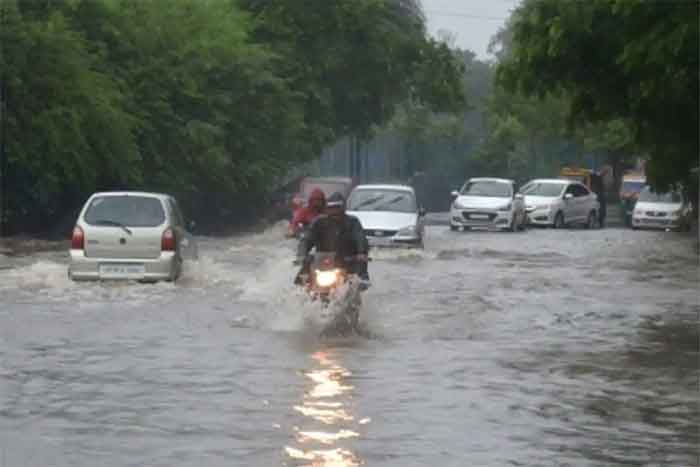
Shimla: The lockdown reached the remote Lahaul-Spiti district of Himachal Pradesh before the Covid pandemic did. Farmers, who suddenly had no way to send their produce outside their region, found a simple solution. They began to host farmers markets called Apni Mandi (Our Market) across the valley. When the initiative earned them profits, farmers were inspired to grow food that was in demand locally.
Farmers of Spiti valley usually send their peas, potatoes, cabbage, broccoli, lettuce and other vegetables to Delhi and Chandigarh for sale. But the valley was cut off from the rest of the country and the rest of the world for over six months due to the pandemic last year. Farmers couldn’t send their produce from Spiti nor could buyers from outside states reach the valley.
Yeshe Dolma, a female farmer from Kaza development block, said fellow growers from the panchayats around Kaza, who like her were sitting on unsold crops, met to discuss the matter and soon came up with the idea of opening a local market.
This market started operating in July 2020, emerging as a lifeline for the farmers in this area. Since transport services were suspended in the state, the farmers set up this market in the building of a rain shelter of the State Transport Corporation. Initially, basic facilities like tents and awnings were made available to them by the officials of the Agriculture Department and the farmers began to trade.
A roaring success
Yeshe revealed that he has earned an income of Rs 1 lakh by selling cabbage, potatoes, and peas in Apni Mandi. After understanding the needs of the local market, new crops have been planted in their fields so that their produce can be consumed in the nearby areas only.
 Tsering Yurzom of Rangrik village, who sold vegetables worth around Rs 2 lakh in the mandi, said that having a market near her home has saved her both time and resources. Her farming costs have reduced due to natural methods of farming and the net profit has also increased. Yurzom said that this idea of selling the products directly to the consumer instead of the arhtiyas (middlemen) has proved beneficial for the farmers of the region.
Tsering Yurzom of Rangrik village, who sold vegetables worth around Rs 2 lakh in the mandi, said that having a market near her home has saved her both time and resources. Her farming costs have reduced due to natural methods of farming and the net profit has also increased. Yurzom said that this idea of selling the products directly to the consumer instead of the arhtiyas (middlemen) has proved beneficial for the farmers of the region.
Rakesh Kumar, a farmer of Chicham village, who is farming at an altitude of 4,300 meters above sea level, said that he has sold peas, potatoes, cabbage, radish, and tomato crops through the local market. He has earned Rs 10 to 15 more per kg than the market price and is very happy. Earlier, he used to worry about his crops getting spoiled as they had to travel long distances, but this is no longer the case due to the local market.
“Now I am worry-free, and I am focusing all my attention on farming, so that I can increase my income further,” he said.
A community effort

This is the first time that the farmers of Himachal have taken the initiative to open a market and are running it as a community. This initiative is also getting the support of the Agriculture Department and the local administration. Sujata Negi, Block Technology Manager of Project ATMA of the Agriculture Department said that so far dozens of farmers of nearby panchayats have benefitted from this market.
“In the initial days of this market, which is open for three days a week, farmers faced difficulties in selling their produce. But gradually things improved, and local buyers started giving preference to the produce of these farmers. Now most of the farmers’ produce is bought by local hotels, restaurants and homestays,” said Negi.
After the removal of lockdown restrictions a few months ago, transportation has resumed. Farmers are now trying to get a permanent building for the market. Talks are going on between the farmers and the local administration regarding this. Kaljang Angchuk, a farmer of Kaza, said that the successful implementation of this mandi has created a new enthusiasm among farmers. Now, many farmers are joining this market and many others come to the market to sell their produce. Customers also wait for the market to open. Many farmers also have regular customers and are selling their produce directly from the farm to these customers, in addition to selling at the market.
The simplicity and success of this initiative has proved that it can be replicated in other states and other remote areas as well. This would mean that farmers can earn their livelihood, despite restrictions and ups and downs of the market. While this initiative empowers the farmers, it also directs them towards community-based agriculture, in which the farmer grows crops according to the needs of the surrounding community, meeting most of its nutritional needs locally.
Raman Kant is a Shimla-based freelance journalist and a member of 101Reporters.com, a pan-India network of grassroots reporters.











































